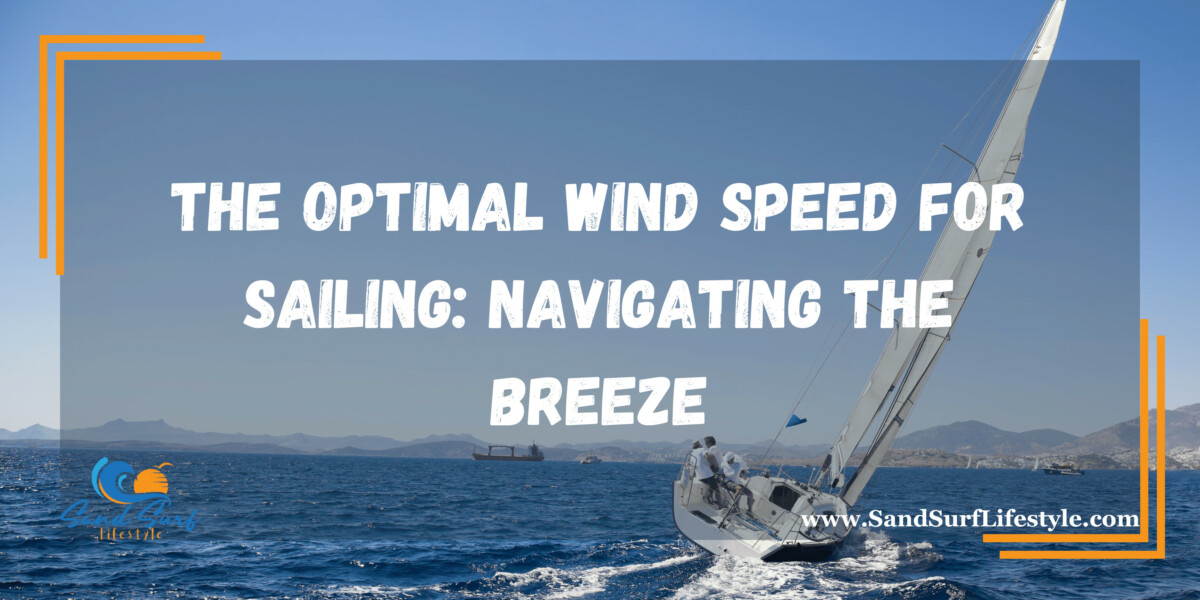Sailing, a timeless and captivating adventure on the open water, relies heavily on the whims of the wind. To harness this force of nature effectively, sailors need to understand the optimal wind speeds for different sailing experiences.
Understanding Wind and Sailing

Before delving into specific wind speeds, it’s essential to comprehend the fundamental relationship between wind and sailing. In the realm of sailing, wind is a multifaceted force, capable of being both an ally and an adversary. A sailboat’s sails, acting as airfoils, harness the kinetic energy of the wind to generate forward propulsion. This harmonious synergy with the elements is what makes sailing an art form and a source of fascination. However, wind’s capricious nature also means that it can pose challenges and dangers if not managed skillfully.
The role of wind in sailing extends beyond mere movement. Wind dictates the entire experience, influencing the speed, stability, and maneuverability of the vessel. It’s a dynamic force that demands respect and understanding from sailors. Whether you’re embarking on a leisurely day sail or competing in a regatta, a comprehensive knowledge of the wind’s impact on your craft is indispensable for safe and enjoyable voyages.
To learn how sailors outwit the wind when tacking in sailing, check out this article.
The Role of Wind Speed
Wind speed is a paramount factor in sailing that exerts a profound influence on the entire nautical journey. Sailors must possess a sound comprehension of wind speed to make prudent decisions while navigating the open waters. Let’s examine the significance of various wind speed ranges and how they affect sailing:
Light Winds (0-5 mph)
Light winds create a serene and peaceful atmosphere for sailing. Boats move at a leisurely pace, making them ideal for relaxing outings. Patience is crucial in these conditions, as progress can be slow.
Moderate Breezes (6-15 mph)
These breezes strike a harmonious balance between speed and control. Sailors can achieve a good cruising speed without being overwhelmed, making it suitable for various sailing activities, including racing and leisurely cruises.
Fresh Breezes (16-25 mph)
Fresh breezes bring excitement to sailing. Boats can attain thrilling speeds, but they also experience heeling, requiring advanced skills for effective management. These conditions are favored by thrill-seekers and experienced sailors.
Strong Winds (26+ mph)
Strong winds offer exhilarating speeds but require the highest level of skill and experience. Safety precautions, such as life jackets and secure equipment, are paramount when sailing in strong winds.
Wind speed is a critical factor that defines the sailing experience. Sailors must adapt their strategies and techniques to the prevailing wind conditions to ensure safe and enjoyable journeys on the water.
Light Winds (0-5 mph)
Light winds, typically ranging from 0 to 5 mph, create a serene and peaceful sailing experience. While these gentle breezes might not provide thrilling speeds, they are ideal for leisurely cruises and relaxed outings. Here’s what to expect in light winds:
1. Calm and Relaxing
Light winds usher in a sense of serenity and relaxation to the sailing experience. These conditions are akin to a gentle, soothing caress of nature, creating a tranquil environment on the water. It’s an opportune time for leisurely activities such as picnics, sunbathing, or simply enjoying a quiet day afloat. The subtle rustling of sails and the gentle lapping of water against the hull provide an ideal backdrop for unwinding and connecting with the peaceful aspects of the aquatic world. Light winds transform sailing into a therapeutic escape, inviting sailors to savor the moment and embrace the calming embrace of the sea.
2. Patience Required
Sailing in light winds demands a significant measure of patience from sailors. These zephyrs may not propel boats at the brisk speeds that thrill-seekers seek. Instead, vessels may glide at a leisurely pace, requiring a composed and patient approach from those on board. Sailors must resist the urge to rush and learn to appreciate the unhurried rhythm of light winds. This leisurely pace offers an opportunity for introspection and mindfulness, allowing sailors to connect with the art of sailing itself. In these conditions, the journey becomes as important as the destination, and patience becomes a valuable companion on the voyage.
3. Sail Size Matters
In light winds, the size of sails takes on heightened significance. Smaller sails prove more effective in these conditions as they are easier to handle and maneuver to capture the available breeze. The reduced surface area of smaller sails allows them to respond more readily to even the faintest of zephyrs, ensuring a consistent source of propulsion. Moreover, the manageable load of smaller sails minimizes the physical effort required from the crew, enhancing the overall sailing experience. Sailors can make the most of light winds by selecting sails that align with these conditions, optimizing their control and enjoyment of the vessel.
Moderate Breezes (6-15 mph)
Moderate breezes, ranging from 6 to 15 mph, are often considered the sweet spot for sailing. These winds provide a balanced mix of excitement and control, making them ideal for various sailing activities:
1. Optimal Speed
Moderate winds offer an ideal balance between the thrill of speed and the comfort of control. Sailboats under the influence of moderate breezes can achieve a sweet spot in cruising speed. They move briskly enough to provide a sense of progress and excitement without reaching speeds that might overwhelm sailors. This equilibrium ensures a satisfying sailing experience where the vessel glides gracefully through the water, responding to the helm with precision. It’s an optimal range that caters to those seeking a pleasant cruising pace, making it suitable for a wide array of sailing adventures, from relaxed day sails to more extended voyages.
2. Stability and Control
Sailing in moderate breezes offers a significant advantage in terms of stability and control. The wind’s force in this range is substantial enough to provide consistent propulsion but remains manageable, resulting in a relatively stable sailing environment. This stability makes moderate breezes particularly appealing to sailors of all levels, from beginners honing their skills to seasoned seafarers seeking a reliable and controlled experience. Novice sailors can learn the ropes with confidence, while experienced hands can focus on refining their techniques or simply enjoy the peace of mind that comes with knowing their vessel is well-behaved.
3. Versatility
One of the most appealing aspects of moderate breezes is their versatility. These winds cater to a wide spectrum of sailing styles and preferences. Whether you’re eager to engage in competitive racing, enjoy a leisurely day on the water, or embark on a more extended voyage, moderate breezes adapt to accommodate your chosen adventure. This adaptability makes them a go-to choice for sailors looking to explore various aspects of the sport. It’s a wind speed range that readily embraces the diversity of sailing experiences, providing the canvas upon which sailors can paint their nautical dreams, no matter how varied they may be.
Fresh Breezes (16-25 mph)

Fresh breezes, ranging from 16 to 25 mph, introduce an element of challenge and exhilaration to sailing. Sailors who seek a bit more excitement often enjoy these conditions:
1. Higher Speeds
Fresh breezes bring a palpable sense of excitement to sailing as boats can attain exhilarating speeds. For those seeking an adrenaline rush or competitive thrill, this wind speed range is an ideal playground. Racing enthusiasts revel in the opportunity to pit their skills against the wind, as fresh breezes propel boats to thrilling velocities. The sensation of speed slicing through the water is unmatched, making fresh breezes a coveted choice for regattas and sailors who crave the heart-pounding rush of high-speed sailing.
2. Heeling and Balance
As the wind’s force intensifies in fresh breezes, sailboats experience heeling, or leaning to one side. This natural phenomenon requires precise sail and weight management to maintain the vessel’s balance and control. Sailors must skillfully adjust the angle and tension of the sails to optimize the boat’s performance while preventing excessive heeling. Effective weight distribution among the crew becomes paramount, and sailors must work in harmony to counterbalance the wind’s force. The art of heeling and balance in fresh breezes adds an intriguing challenge to sailing, demanding a keen understanding of the vessel’s dynamics.
3. Experience Required
Sailing in fresh breezes is an exhilarating but demanding endeavor that demands a higher level of skill and experience. The increased forces at play necessitate a deep understanding of sail trim, boat handling, and tactical decision-making. Novice sailors may find fresh breezes overwhelming and challenging to manage effectively. It’s essential to have a seasoned hand at the helm to ensure the safety and stability of the vessel. Experience gained through time spent on the water and exposure to varying wind conditions is invaluable when navigating the dynamic and thrilling world of fresh breezes, where mastery is the key to harnessing the wind’s full potential.
Strong Winds (26+ mph)
Strong winds, exceeding 26 mph, can be challenging and even dangerous for inexperienced sailors. While expert sailors might revel in the sheer power of the wind, caution is paramount:
1. Extreme Speeds
When the wind intensifies into strong gusts, sailboats have the potential to reach exhilarating and, at times, even extreme speeds. These high velocities can provide an adrenaline rush like no other, appealing to the most adventurous of sailors. However, this thrill comes with a trade-off: the increased risk of capsizing or causing damage to the vessel. The sheer force of strong winds can push a boat to its limits, requiring careful management and a skilled hand at the helm to prevent accidents and ensure a safe and enjoyable experience on the water.
2. Advanced Skills Required
Sailing in strong winds demands a repertoire of advanced sailing skills. Precise sail adjustments become critical as gusts buffet the boat, requiring quick and calculated responses to maintain control. The ability to anticipate changing conditions and adapt swiftly is vital, as strong winds can be unpredictable. Advanced sailors have honed their techniques over time, developing the proficiency needed to navigate the challenges posed by formidable winds. These skills include expert sail handling, fine-tuned steering, and the ability to read wind patterns with precision.
3. Safety First
Above all else, safety must take precedence when sailing in strong winds. Life jackets, harnesses, and other safety gear are non-negotiable necessities. Rigorous safety protocols, such as regular safety briefings and drills, should be established and adhered to rigorously. It’s paramount that all members of the crew understand their roles and responsibilities in ensuring everyone’s well-being. The forces at play in strong winds can pose significant risks, making it crucial to prioritize safety measures to prevent accidents, injuries, or emergencies. Whether you’re an experienced sailor or a novice venturing into strong winds, a commitment to safety should be unwavering, providing peace of mind amid the thrilling challenges of sailing in these conditions.
To learn about riding the wind and sailing knockdowns, check out this article.
Conclusion
In the world of sailing, the optimal wind speed is not a fixed number but varies depending on your experience, preferences, and the type of sailing you intend to undertake. Light winds offer serenity and relaxation, moderate breezes provide balance, fresh breezes bring excitement, and strong winds deliver thrilling speeds for seasoned sailors.
The best wind speed for sailing in mph is the one that aligns with your skill level, the type of adventure you seek, and your comfort zone. As you gain experience, you’ll develop a keen sense of which wind conditions suit your sailing style best. So, whether you’re a novice or a seasoned sailor, the world of sailing offers something for everyone, with the wind as your trusted companion on this remarkable journey.
Please note that the contents of this blog are for informational and entertainment purposes only and should not be construed as legal advice. Any action taken based on the information provided in this blog is solely at your own risk. Additionally, all images used in this blog are generated under the CC0 license of Creative Commons, which means they are free to use for any purpose without attribution.

